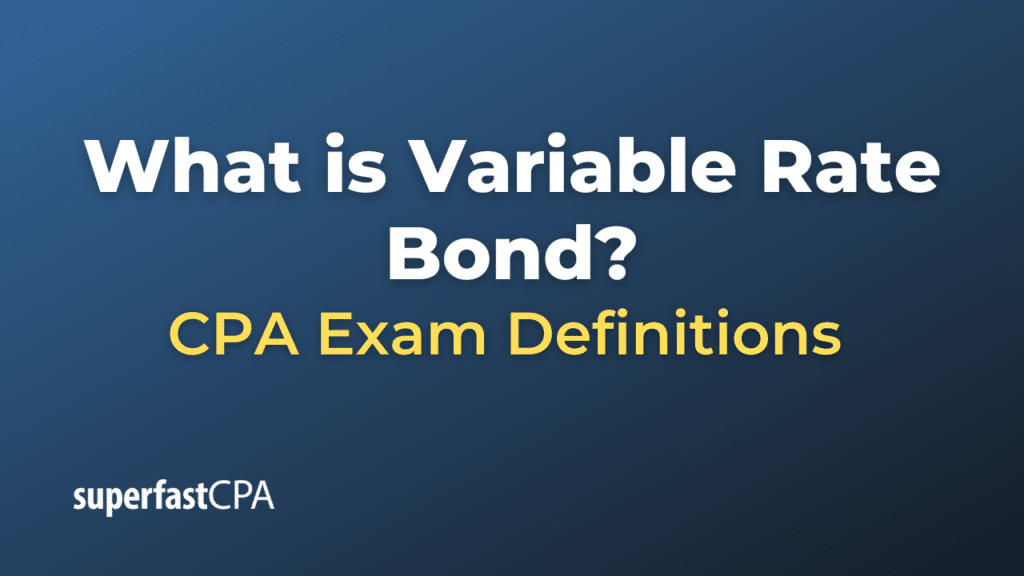Variable Rate Bond
A Variable Rate Bond, also known as a Floating Rate Bond, is a type of debt security where the interest rate payments are not fixed but instead fluctuate over time. These fluctuations are usually tied to a benchmark interest rate, such as the LIBOR (London Interbank Offered Rate), the Federal Funds Rate, or another market index. The interest rate on the bond is adjusted at specified intervals, which could be daily, monthly, quarterly, semi-annually, or annually, depending on the terms of the bond.
Because the interest rate can change, variable rate bonds are generally less sensitive to interest rate risk compared to fixed-rate bonds. In a rising interest rate environment, the bond’s rate will increase, potentially providing higher income for the bondholder. Conversely, in a declining interest rate environment, the interest payments to bondholders will decrease.
Features:
- Adjustment Period: The rate adjustments are made at predetermined intervals.
- Benchmark Rate: The variable rate is often calculated as the benchmark rate plus a spread. The spread remains constant, but the benchmark rate will vary.
- Caps and Floors: Some variable rate bonds may have upper (cap) and lower (floor) limits on how much the rate can change.
- Risk Profile: Variable rate bonds typically have lower interest rate risk but may have higher credit risk or market risk.
Example of Variable Rate Bond
Let’s take a more detailed example to explain how a Variable Rate Bond might work.
The Scenario:
Let’s assume you invest $100,000 in a 5-year variable rate bond issued by a corporation. The bond’s interest rate is set to adjust every year and is tied to the U.S. Treasury 1-year rate plus a fixed spread of 2%.
Year 1:
- 1-Year U.S. Treasury Rate: 1%
- Your Bond’s Interest Rate: 1% (Treasury Rate) + 2% (Spread) = 3%
- Interest Earned: $100,000 * 3% = $3,000
Year 2:
- 1-Year U.S. Treasury Rate: Rises to 1.5%
- New Bond’s Interest Rate: 1.5% (Treasury Rate) + 2% (Spread) = 3.5%
- Interest Earned: $100,000 * 3.5% = $3,500
Year 3:
- 1-Year U.S. Treasury Rate: Drops to 0.5%
- New Bond’s Interest Rate: 0.5% (Treasury Rate) + 2% (Spread) = 2.5%
- Interest Earned: $100,000 * 2.5% = $2,500
Year 4:
- 1-Year U.S. Treasury Rate: Remains at 0.5%
- New Bond’s Interest Rate: 0.5% (Treasury Rate) + 2% (Spread) = 2.5%
- Interest Earned: $100,000 * 2.5% = $2,500
Year 5:
- 1-Year U.S. Treasury Rate: Increases to 2%
- New Bond’s Interest Rate: 2% (Treasury Rate) + 2% (Spread) = 4%
- Interest Earned: $100,000 * 4% = $4,000
Summary:
In this example, your interest payments fluctuated each year due to changes in the 1-Year U.S. Treasury rate. The bond’s interest rate changed from 3%, to 3.5%, down to 2.5%, and finally up to 4%, reflecting the movements in the benchmark rate.
This is beneficial if you believe that interest rates are going to rise because your interest payments will increase accordingly. However, if rates fall, so will your returns, which could be a drawback if you were counting on a fixed income from your investment.
Variable Rate Bonds offer a trade-off: lower interest rate risk but potentially higher market and credit risks. The bond’s value will be less sensitive to changes in market interest rates, but the income it generates will fluctuate over time.













